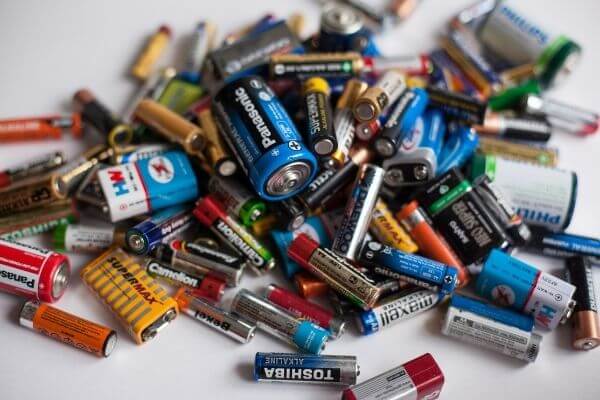Many things in our lives would be no use to us without batteries to power them. Batteries power our phones and laptops, our cars, our tv remotes, our kid’s toys and even our hearing aids. Batteries are important and so is battery recycling.
There are lots of different types of batteries and they each contain different chemicals and materials. Many of these chemicals are quite toxic to us and the environment. Recycling batteries helps make sure that we handle these toxic chemicals safely.
Recycling batteries also helps reuse valuable resources. There are a lot of materials in batteries that can be recovered and reused. These materials can be used to make new batteries or other useful items. Lead-acid batteries are a good example. Every part of a lead battery can be recovered and reused to make a new one including the lead, plastic and even the sulfuric acid.
Below we will help you understand the basics of what a battery is and how easy it is to recycle them.
What is a Battery
The main purpose of a battery is to supply power without the need for you to connect to the power in your home. It creates this power by converting chemical energy into electrical energy, all this occurs inside the battery.
Batteries consist of one or more electrochemical cells. Each cell is made up of three main parts which are encased in either plastic or metal. There are two electrodes, a positive electrode (or cathode) and a negative electrode (or anode). These two electrodes are separated by the third component, the electrolyte. An electrolyte is a chemical in the form of a fluid or gel.
When you connect to a battery an electrical current is produced from the chemical reaction between the electrolyte and the anode. This reaction creates spare electrons, which can leave the battery through its negative (-) terminal.
On the outside, these electrons continue their journey through the circuit of the item the battery is powering and back into the positive (+) terminal, which connects to the battery’s cathode.
At the cathode another reaction occurs between the cathode and the electrolyte, enabling the cathode to accept the electrons.
The process then repeats until the chemical reaction has transformed all of the electrolyte. At that point the battery is flat and you are left wondering why your TV remote is no longer working.
If you want to know more about how a battery works then check out this great explanation by Explain That Stuff.
Types of Batteries
Although there are many different types of batteries, each with a different chemical makeup they can be grouped into two main types, primary and secondary. Primary batteries are designed to be used until they run out of oomph, power that is. Then they are no longer useful and must be replaced.
Secondary batteries are able to be recharged, they are more often referred to as rechargeable batteries. Even though they are rechargeable, their capacity to store energy and supply power does degrade over time. They too come to the end of their life.
Primary Batteries
Some common types of primary batteries are:
Zinc-carbon – These are usually the common everyday batteries like AA and AAA. They use a carbon rod for their positive electrode and a zinc allow for their negative electrode. The electrolyte is a carbon and manganese oxide.
Alkaline – Alkaline batteries have replaced zinc-carbon batteries in many applications. Alkaline batteries have a manganese (IV) oxide positive electrode and a zinc negative electrode with an electrolyte of a concentrated alkaline solution.
Zinc-air – These are commonly used for hearing aids because they can store a lot of energy in a small package. This type of battery is activated by removing a seal that allows oxygen to pass into the cell and start the chemical reaction.
Secondary or Rechargeable Batteries
Lead-acid – The most likely place you will find a lead-acid battery is in a car or boat. As suggested by the name these batteries use lead. The positive electrode is made of lead metal and the cathode is made from lead dioxide. The electrolyte solution used is sulphuric acid, a highly corrosive chemical.
Nickel-metal-hydride (NiMH) – They have electrodes of nickel oxide hydroxide and negative electrodes of a hydrogen-absorbing alloy. These were used in early mobile phones and other electronic gadgets however lithium-ion batteries are more popular now.
Lithium-ion – These batteries usually have an anode of graphite but the cathode and electrolyte vary. The cathode is commonly a combination of lithium, oxygen and a metal, such as lithium cobalt oxide. The electrolytes used can be liquid or solid, an example is lithium salt in an organic solution.
Nickel-cadmium – They use a positive electrode of nickel hydroxide, a negative electrode of cadmium hydroxide and an electrolyte of potassium hydroxide.
Examples of Common Household Batteries
Which battery is used in which device can vary and is ever-changing as technology improves. Here’s a great link from Turbo Future with a comparison of the different types of batteries and the advantages and disadvantages if you are interested.
Below are some common examples of batteries you may have around the home.
Common Single Use Batteries
You will recognise most of the single-use batteries as the AA, AAA, C and D size batteries as well as the button batteries. The majority of these are now alkaline batteries although there are other types. The second most common is the zinc-carbon battery which was commonly used before alkaline.
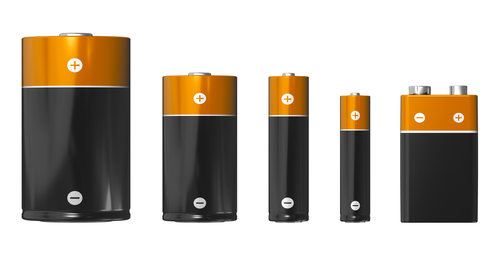
These varying sizes of batteries generally power many items in our houses. Examples include tv remotes, our kid’s toys and our gadgets, flashlights, nightlights, even our Christmas lights.
The other common single-use type is the button batteries. These are the small round coin-like batteries you find in watches and other small battery-operated items. They used to be made with mercury but luckily this has been phased out in most cases. Nowadays they can be made from many different types of cell batteries including alkaline, zinc, silver oxide, carbon batteries or lithium. These are used in hearing aids, car keyless-entry remotes, calculators, toys, or small candles and other gadgets.
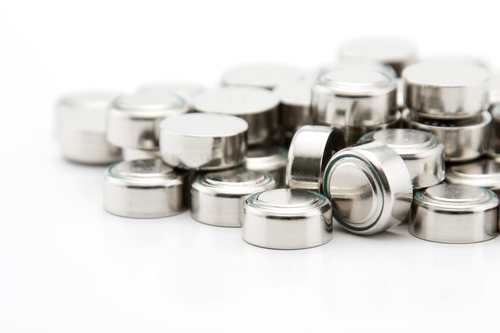
Common rechargeable batteries
- Cameras – usually use nickel-metal hydride
- E-cigarettes or Vapes – use lithium-ion batteries.
- Cordless power tools – might be nickel-cadmium, nickel-metal hydride or lithium-ion batteries
- Mobile phones – usually lithium-ion rechargeable batteries, however technology is always changing and some use a lithium polymer battery.
- Laptop computers and other digital items- usually lithium-ion rechargeable batteries
- Electric shavers – might be lithium-ion, nickel-cadmium or nickel-metal hydride.
- Electric toothbrushes – many use nickel-cadmium batteries but are now moving to lithium batteries.
Why Recycle Batteries
Batteries can be a risk to human health and the environment if they are not disposed of properly. They also contain valuable metals that can be recovered and used again. The benefits of battery recycling are:
- To keep toxic and hazardous substances from the environment
- Reuse valuable resources
- Reduce the need to extract more resources
- Save energy
- Reduce the risk of fire from lithium-ion batteries
- Reduce the amount of waste we produce
How to Recycle Batteries
Batteries are one of the simplest waste streams to recycle. There are specialist recyclers that you can take them to. Plus, many stores, such as Walmart or Aldi, provide a drop-off point for batteries.
Simply collect the batteries in a safe place away from children, and the next time you head out to one of the stores, take them and drop them in the collection box. Be sure to check what type of battery the collection takes before you head there. We provide links below.
If you have an unusual or less common battery, there are other programs that accept these types of batteries. For example, mechanics will usually take old lead-acid car batteries for you.
Batteries associated with E-waste can be included in e-waste drop-offs and collections. Just be sure to check the instructions for the local collection. For example, you can recycle mobile phones along with their batteries in many e-waste collection programs.
Where to Recycle Batteries
Simply drop your batteries off at the appropriate recycling center or store.
The United States and Canada
United Kingdom
Australia
- B-Cycle
- Aldi
- Battery World
- Officeworks – only some stores – call them to check
- Australian ABRI Initiative
New Zealand
Can leaking batteries be recycled?
You can still recycle leaking or damaged batteries; however, keep them separate from the others. Place them in a Ziploc bag or other plastic bag and label them as damaged. Then place them in the drop off box in the bag. Be careful not to get any of the leaking material on your hands, use gloves if necessary, and clean up.
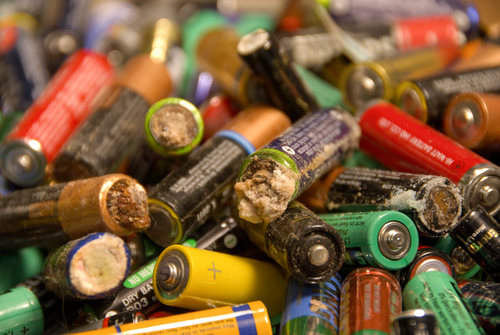
What Are Recycled Batteries Made Into
Batteries contain many different chemicals and precious metals. These metals can be recovered from old batteries and reused. Some examples are lithium, nickel, lead, zinc, or cadmium. The cadmium, cobalt, nickel, and copper can be used to make new batteries.
Cadmium can also be used in stainless steel or similar high-end products. Manganese oxide in alkaline batteries is used in some plastics and ceramics products. The lithium from lithium-ion batteries can be used in lubricants, glass, ceramics, and other applications.
Iron from lead-acid batteries can be recovered relatively easily. In fact, lead-acid batteries are recycled via a closed-loop process where each battery is recycled into a new one. Recycling rates are at almost 100% as a result.
The process of recycling batteries is very energy-intensive and costly. To counter this issue, some countries have added a tariff to the cost of new batteries to ensure sufficient funds for recycling them. Luckily new technologies are being worked on to improve processes all the time.
What Happens When They’re Not Recycled
Batteries contain many different chemicals, some of which are toxic. When batteries are disposed of in your general rubbish, they will be sent to landfill. After a time, the metal cylinder around the battery cell will corrode, and the contents will seep out. This can contaminate not only the landfill site, but it can get into waterways. Scientists have already discovered traces of some of these chemicals in the ocean.
Lithium style batteries are also dangerous. If they still have a charge, they can potentially ignite if damaged and start a fire in the landfill.
It is very important that you recycle your batteries.
Ways You Can Help
When it comes to powering our digital lives, there are not many alternatives to batteries other than to reduce our use of technology. That’s pretty unlikely. So, what can we do to improve things?
- Choose appliances that plug-in, ideally using renewable electricity.
- Use up the charge in batteries as much as you can. Some electronic items do not require as much power as others. For example, running a torch may take a bit of power but running a wall clock requires a lot less, and the battery may last a lot longer. Shift your batteries around your devices until they are fully flat.
- Switch to rechargeable batteries where possible. Rechargeable batteries are not only better for the environment, but they save you money too.
- Make sure that we recycle all of our batteries, rechargeable, and non-rechargeable.
Note, always handle batteries safely. Keep them away from children, particularly the smaller ones. If you have batteries that have leaked, be careful, and do not touch them. Wash your hands if you have come in contact with them.
HOW TO RECYCLE
BATTERIES
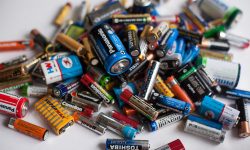
Can you recycle it?
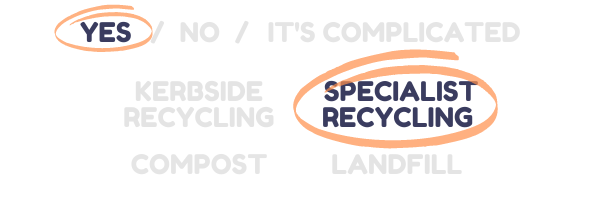
Always check with your local Authority .
Instructions
- Never place in your general waste bin
- Never place in your curbside recycling (unless your local council has a program)
- Find your local drop off point above.
- Check what batteries they will take.
- E-waste batteries can be recycled with the item.
- Car batteries go to your mechanic or a specialist recycler.
Buy Recycled
Some batteries are listed as having recycled content and it is good to buy these if you can. The best option is to buy rechargeable batteries however.
The Wrap
Our lives are filled with battery-operated appliances providing us with more and more convenience every day. These batteries are filled with chemicals and toxic materials, and we must treat them with respect. Recycling batteries helps ensure that these materials do not end up in the environment. It also means the materials can be used again, saving energy and resources.
There are many different types of batteries, and it can be hard to identify the different types. The best advice is this:
- Never put spent batteries in your general waste.
- Never put spent batteries in your curbside recycling bin.
- Recycle all batteries regardless of their type
- Contact your local recycling program to find a drop off center.
- Take your batteries to the free drop off or collection drive.
- Switch to rechargeable batteries where you can.
We can all be a part of the solution.
You can learn more about e-waste here.
- Chris Woodford, 2020, Batteries, Explainthatstuff.com
- Dr Anand Bhatt, Professor Ray Withers FAA, and Professor Guoxiu Wang, Lithium-ion batteries, Australian Academy of Science
- Dr Anand Bhatt, Professor Ray Withers FAA, and Professor Guoxiu Wang, Battery Types, Australian Academy of Science
- Eugene Brennan, 2020, Which Battery Is Best? Choosing Between Alkaline, Zinc, Lithium-Ion, and Lead-Acid, Turbofuture.com
- 2019, What The Heck is a NiCd Battery?, Batterystuff.com
- Recycling Today, 2017, Study finds nearly 100% recycling rate for lead batteries, Recyclingtoday.com
- Battery University, 2019, BU-705: How to Recycle Batteries, Batteryuniversity.com
- Resource, 2016, What happens when batteries are recycled?, resource.co
- Sustainability Victoria Website
- Battery recycling, Wikipedia


